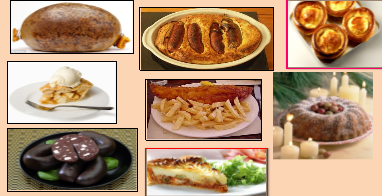Урок "«Англійська кухня. English cuisine» (names of dishes and ingredients for their preparation)"

МЕТОДИЧНА РОЗРОБКА
відкритого уроку на тему:
ENGLISH CUISINE (names of dishes and ingredients for their preparation)
Розробила викладач:
Н.О.Гонтарюк
Полтава - 2021
Методична розробка уроку
З предмету «Англійська мова»
 Предмет: Англійська мова
Предмет: Англійська мова
Тема: «Англійська кухня. English cuisine» (names of dishes and ingredients for their preparation)
Формування компетентностей
Предметна компетентність: формувати знання учнів про основні англійські національні страви; ознайомити їх з особливостями англійської кухні, з традиціями англійської кухні; тренувати вживання вивченої лексики в усному мовленні та на письмі, навчати учнів аудіювання з теми з метою виконання тестових завдань типу «виберіть зайве», закріпити граматичний матеріал: 3-rd Conditional, навчати читання з метою вивчення нової лексики; формувати комунікативну компетенцію учнів , навчати говоріння та письма на основі фразової єдності за опорами.
Ключові компетентності:
Спілкування державною мовою – здатність усно і письмово описувати факти, володіти найважливішими функціями, що включають, крім мовної діяльності людини, візуальні і тактильні способи сприйняття нею інформації у вигляді жестів, міміки, пози, інтонації. Усвідомлювати ролі ефективного спілкування.
Спілкування іноземною мовою - формування в учнів умінь і навичок належно розуміти висловлене іноземною мовою, усно і письмово висловлювати і тлумачити лексику, думки(через слухання, говоріння, читання і письмо)
Уміння навчатися впродовж життя - здатність до пошуку та засвоєння нових знань, набуття нових вмінь і навичок, оцінювати власні результати навчання, навчатися впродовж життя
Загальнокультурної - формувати кулінарні навички і вміння, мовну здогадку і мовну реакцію, пізнавальну цікавість учнів, культуру спілкування в ситуації «Sunday lunch», виховувати культуру спілкування, інтерес до традицій українського народу
Обладнання і матеріали: презентація «English cuisine», цифрові технології «Wordwall», «Jamboard»).
Тип уроку: комбінований
Міжпредметні зв’язки: спецтехнологія, історія, українська мова, географія
Хід уроку
I.Початок уроку.
Привітання.
Організація групи.
Введення в іншомовну атмосферу, мовленнєва розминка.
Teacher: Good morning, boys, girls and quest! I’m glad to see you. How are you doing? Everybody looks wonderful today. Who is absent today. I hope everybody is in a good mood and is ready to start our lesson. Please, look at the screen and try to read the motto of our lesson: Today we are going to speak about the …..
ІІ. Перевірка домашнього завдання
And now let's check the homework
۞ Write a short report about your favorite recipe for Ukrainian dishes.
ІІІ. Актуалізація і корекція опорних знань і вмінь учнів.
Brainstorming (Мозковий штурм) (за допомогою платформи Wordwall)
Let’s start for the lesson with the game «АВС». https://wordwall.net/uk/resource/24628556
2) T: And now I will take a short interview with you, you will answer questions using the platform - random maps (платформа Wordwall).
https://wordwall.net/uk/resource/24629226
IV. Повідомлення теми та мети уроку
V. Вивчення нового матеріалу
T: We continue to speak about the food. The topic which we are going to learn today is very interesting and closely connected with Great Britain. It is a part of the British life. First I propose you to look at the illustrations on the blackboard and tell what is the topic of our lesson.
As you understrand the title of our today's lesson is “Traditional English Cuisine”. We will speak about English dishes. From the previous lesson you know about food in Ukraine and now I invite you to travel to England. But first of all I want to ask you: “What is your favourite food in general?”
P1: My favourite food is borsch.
P2: My favourite food is fried potatoes.
P3: My favourite food is chocolate. etc.
T: Учні в творчих групах (black pudding, Shepherd’s pie, Yorkshire pudding, fish and chips and Toad in the Hole) виконували випереджувальне завдання – вивчали страви англійської кухні. Представники груп по черзі дають характеристику цим стравам. Students in creative groups (black pudding, Shepherd’s pie, Yorkshire pudding, fish and chips and Toad in the Hole) performed an advanced task - learning English cuisine. Representatives of groups in turn give a description of these dishes.
Teacher: Well done, now. Look at the picture we see on the screen and name traditional British dishes. Say what would you like to taste? If you can, name at least some ingredients of the dish.
 Pupils’ possible answers:
Pupils’ possible answers:
I’d like to eat black pudding because I like meat very much. The ingredients are blood, meat, some spices, some oil, fat, some salt.
I’d like to eat Shepherd`s pie. The ingredients are vegetables, meat, cheese, some flour, eggs, milk, some spices, some oil, some butter and some salt.
I’d like to eat Yorkshire pudding. The ingredients are some flour, eggs, some milk, some spices, some oil and some salt.
It is black pudding. It is fish and chips. The ingredients are fish, potato, some flour, eggs, some spices, some oil and some salt.
I’d like to eat Toad in the Hole, a traditional British dish consisting of sausages in Yorkshire pudding batter, usually served with vegetables and onion gravy.
I’d like to eat haggis. I know that it consists of minced heart,lungs and liver of lamb, mixed with onions,oatmeal and spieces, boiled in the sheep’s stomach.
Presentation.
It’s always interesting for people from different countries to find an interesting topic to speak on. And now we are going to discuss peculiarities of cooking in Great Britain.
To begin with, let’s listen to the reports prepared by our pupils. While listening put down common and different features of British and Ukrainian cuisine.
Діалогічне мовлення для систематизації прослуханого матеріалу
And now you are listening and watching to a short video about British cuisine.
After watching the video, you need to make a diagram about what the English people eat for breakfast, lunch and dinner. (за допомогою платформи Jamboard)
Diagram
![]()
![]()
![]()
![]()
![]()

Task: Complete the diagram with the topical words. What do people usually have for meals in Great Britain? Take turns to come to the blackboard and write.
VI. Закріплення, систематизація та узагальнення знань
- «Фото – вікторина»
- «Асоціативна гра» Openwork tile (Ажурна плитка) – (за наявності часу)
To consolidate and generalize knowledge, we will perform a photo quiz with you.
Interactive exercise “Associative game”. Інтерактивна вправа «Асоціативна гра».
T: As you know our mood depends on many things. And one of them is our meal. I'd like to add one more saying “A hungry man is an angry man”. What is food for us? What does the word “Food” mean for you? We can answer this question with the help of associative game. Tell me any associative words to keyword “Food”. (за допомогою платформи Jamboard).
/https://jamboard.google.com/d/1lhZ8qNIwUgGDZT4KZF2JKlHfgjN1Fky31QypGZBJLls/edit?usp=sharing
P1: borsch.
P2: porridge.
P3: roast chicken.
P4: mashed potatoes.
P5: pancakes, etc.
2. Reports on English cuisine.
P1: Breakfast
A traditional English breakfast is a very big meal – sausages, bacon, eggs, tomatoes, mushrooms … . But nowadays many people just have cereal with milk and sugar, or toast with marmalade, jam, or honey. Marmalade and jam are not the same! Marmalade is made from oranges and jam is made from other fruit. The traditional breakfast drink is tea , which people have with cold milk. Some people have coffee, often instant coffee, which is made with just hot water. Many visitors to Britain find this coffee disgusting!
P2: Lunch
For many people lunch is a quick meal. In cities there are a lot of sandwich bars, where office workers can choose the kind of bread they want – brown, white, or a roll – and then all sorts of salad and meat or fish to go in the sandwich. Pubs often serve good, cheap food, both hot and cold. Schoolchildren can have a hot meal at school, but many just take a snack from home – a sandwich, a drink, some fruit, and perhaps some crisps.
P3: “Tea”
“Tea” means two things. It is a drink and a meal! Some people have afternoon tea, with sandwiches, cakes, and, of course, a cup of tea. Cream teas are popular. You have scones (a kind of cake) with cream and jam.
P4: Evening meal
The evening meal is the main meal of the day for many people. They usually have it quite early, between 6.00 and 8.00, and often the whole family eats together.
P5: Sunday lunch
On Sunday many families have a traditional lunch. They have roast meat, either beef, lamb, chicken, or pork, with potatoes, vegetables, and gravy. Gravy is a sauce made from the meat juices.
P6: British Meal
The British like food from other countries, too, especially Italian, French, Chinese and Indian. People often get take- away meals – you buy the food at the restaurant and then bring it home to eat. Eating in Britain is quite international!
Post – listening task for all pupils.
Questions on the screen.
1. How many meals a day has an Englishman?
2. What is a traditional English breakfast?
3. What are the gastronomic wonders of the world?
4. What kind of meal is lunch?
5. Where do usually office workers and schoolchildren can have their lunch/
6. What does “tea” means?
7. What do some people have afternoon tea with?
8. Cream teas are popular, aren’t they?
9. What is the main meal of the day?
10. When do many people have it?
11. What kind of meal do many families have on Sundays?
12. Would you like to see a film about Sunday lunch?
VII. Аргументоване пояснення домашнього завдання
Write a letter to your Ukrainian friend about the English tea-party.
- Prepare for the test by the link https://learningapps.org/2446509
VIIІ. Evaluation. (Оцінювання).
T: We’ll have to stop now. That’s all for today. I'd like to thank you for good work at the lesson. All of you worked very well. I give excellent marks to..., good - to:, etc. I wish you good luck.
-
ПОДЯКА сайту за допомогу!
-


про публікацію авторської розробки
Додати розробку
